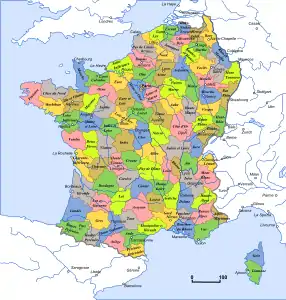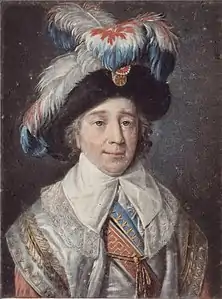French First Republic
In the history of France, the First Republic (French: Première République), officially the French Republic (République française), was founded on 22 September 1792 during the French Revolution. The First Republic lasted until the declaration of the First Empire in 1804 under Napoleon, although the form of the government changed several times. This period was characterized by the fall of the monarchy, the establishment of the National Convention and the Reign of Terror, the Thermidorian Reaction and the founding of the Directory, and, finally, the creation of the Consulate and Napoleon's rise to power.
French Republic République française | |||||||||||||||||||||
|---|---|---|---|---|---|---|---|---|---|---|---|---|---|---|---|---|---|---|---|---|---|
| 1792–1804 | |||||||||||||||||||||
.svg.png.webp) Flag
(1794–1804) | |||||||||||||||||||||
 The French Republic in 1801 | |||||||||||||||||||||
| Capital | Paris | ||||||||||||||||||||
| Common languages | |||||||||||||||||||||
| Religion |
| ||||||||||||||||||||
| Government | 1792–1795 Authoritarian directorial revolutionary republic
1795–1799 Oligarchical directorial republic 1799–1804 Autocratic republic | ||||||||||||||||||||
| President of the National Convention | |||||||||||||||||||||
• 1792 | Jérôme Pétion de Villeneuve (first) | ||||||||||||||||||||
• 1795 | Jean Joseph Victor Génissieu (last) | ||||||||||||||||||||
| President of the Directory | |||||||||||||||||||||
• 1795–1799 | By rotation: 3 months duration | ||||||||||||||||||||
| First Consul | |||||||||||||||||||||
• 1799–1804 | Napoléon Bonaparte | ||||||||||||||||||||
| Legislature | Parliament | ||||||||||||||||||||
| Council of Ancients (1795–1799) | |||||||||||||||||||||
| |||||||||||||||||||||
| Historical era | French Revolutionary Wars Napoleonic Wars | ||||||||||||||||||||
| 21 September 1792 | |||||||||||||||||||||
| 10 March 1793 – 27 July 1794 | |||||||||||||||||||||
| 27 July 1794 | |||||||||||||||||||||
| 6 September 1795 | |||||||||||||||||||||
| 4 September 1797 | |||||||||||||||||||||
| 18 June 1799 | |||||||||||||||||||||
| 9 November 1799 | |||||||||||||||||||||
| 24 December 1799 | |||||||||||||||||||||
• French Revolutionary Wars ends | 27 March 1802 | ||||||||||||||||||||
• Napoleonic Wars begins | 18 May 1803 | ||||||||||||||||||||
| 18 May 1804 | |||||||||||||||||||||
• Officially renamed to the “French Empire” | 1 January 1809 1804 | ||||||||||||||||||||
| Currency | livre (to 1794), franc, assignat | ||||||||||||||||||||
| |||||||||||||||||||||
| Today part of | |||||||||||||||||||||
End of the monarchy in France
Under the Legislative Assembly, which was in power before the proclamation of the First Republic , France was engaged in war with Prussia and Austria. In July 1792, the Duke of Brunswick, commanding general of the Austro–Prussian Army, issued his Brunswick Manifesto, in which he threatened the destruction of Paris should any harm come to the King Louis XVI of France. The foreign threat exacerbated France's political turmoil amid the French Revolution and deepened the passion and sense of urgency among the various factions. In the violence of 10 August 1792, citizens stormed the Tuileries Palace, killing six hundred of the King's Swiss guards and insisting on the removal of the king.[2] A renewed fear of anti-revolutionary action prompted further violence, and in the first week of September 1792, mobs of Parisians broke into the city's prisons, killing over half of the prisoners. This included nobles, clergymen, and political prisoners, but also numerous common criminals, such as prostitutes and petty thieves, many murdered in their cells—raped, stabbed, and slashed to death. This became known as the September Massacres.[3]
Part of a series on the |
|---|
| History of France |
 |
| Timeline |
|
|
National Convention
As a result of the spike in public violence and the political instability of the constitutional monarchy, a party of six members of France's Legislative Assembly was assigned the task of overseeing elections. The resulting Convention was founded with the dual purpose of abolishing the monarchy and drafting a new constitution. The convention's first act was to establish the French First Republic and officially strip the king of all political powers. Louis XVI, by then a private citizen bearing his family name of Capet, was subsequently put on trial for crimes of high treason starting in December 1792. On 16 January 1793 he was convicted, and on 21 January, he was executed by guillotine.[4]
Throughout the winter of 1792 and spring of 1793, Paris was plagued by food riots and mass hunger. The new Convention did little to remedy the problem until late spring of 1793, occupied instead with matters of war. Finally, on 6 April 1793, the Convention created the Committee of Public Safety, and was given a monumental task: "To deal with the radical movements of the Enragés, food shortages and riots, the revolt in the Vendée and in Brittany, recent defeats of its armies, and the desertion of its commanding general."[5] Most notably, the Committee of Public Safety instated a policy of terror, and the guillotine began to fall on perceived enemies of the republic at an ever-increasing rate, beginning the period known today as the Reign of Terror.[6]
Despite growing discontent with the National Convention as a ruling body, in June the Convention drafted the Constitution of 1793, which was ratified by popular vote in early August. However, the Committee of Public Safety was seen as an "emergency" government, and the rights guaranteed by the 1789 Declaration of the Rights of Man and of the Citizen and the new constitution were suspended under its control.
Directory
After the arrest and execution of Robespierre on 28 July 1794, the Jacobin club was closed, and the surviving Girondins were reinstated. A year later, the National Convention adopted the Constitution of the Year III. They reestablished freedom of worship, began releasing large numbers of prisoners, and most importantly, initiated elections for a new legislative body. On 3 November 1795, the Directory was established. Under this system, France was led by a bicameral Parliament, consisting of an upper chamber called the Council of Elders (with 250 members) and a lower chamber called the Council of Five Hundred (with, accordingly, 500 members), and a collective Executive of five members called the Directory (from which the historical period gets its name). Due to internal instability, caused by hyperinflation of the paper monies called Assignats,[7] and French military disasters in 1798 and 1799, the Directory lasted only four years, until overthrown in 1799.
Consulate
The period known as the French Consulate began with the coup of 18 Brumaire in 1799. Members of the Directory itself planned the coup, indicating clearly the failing power of the Directory. Napoleon Bonaparte was a co-conspirator in the coup, and became head of the government as the First Consul. He would later proclaim himself Emperor of the French, ending the First French Republic and ushering in the French First Empire.[8]
Leading heads of the Republic
The constitution of the republic did not provide for a formal head of state or a head of government. It could be discussed whether the head of state would have been the president of the National Assembly under international law. However, this changed every two weeks and was therefore not formative. The following list is based on the actual positions of power within the executive:
- Political factions
Bonapartist
Independent
Girondins
The Mountain
The Plain
Thermidorians
| No. | Portrait | Name (birth and death) |
Term of office | Political party | Ref. | |||
|---|---|---|---|---|---|---|---|---|
%252C_orateur_et_homme_politique_-_P712_-_mus%C3%A9e_Carnavalet.jpg.webp) |
Georges Danton (1759–1794) |
21 September 1792 | 9 October 1792 | Cordeliers (The Mountain) | ||||
 |
Jean-Marie Roland de la Platière (1734–1793) |
9 October 1792 | 23 January 1793 | Girondins | ||||
.JPG.webp) |
Étienne Clavière (1735–1793) |
23 January 1793 | 2 June 1793 | Girondins | ||||
%252C_orateur_et_homme_politique_-_P712_-_mus%C3%A9e_Carnavalet.jpg.webp) |
Georges Danton (1759–1794) |
2 June 1793 | 10 July 1793 | Cordeliers (The Mountain) | ||||
| 10 July 1793 | 27 July 1793 | |||||||
 |
Maximilien Robespierre (1758–1794) |
27 July 1793 | 27 July 1794 | Jacobins (The Mountain) | ||||
 |
Lazare Carnot (1753–1823) |
27 July 1794 | 6 October 1794 | The Plain | ||||
 |
Jean-Jacques-Régis de Cambacérès (1753–1824) |
6 October 1794 | 8 November 1794 | The Plain | ||||
 |
Lazare Carnot (1753–1823) |
8 November 1794 | 3 March 1795 | The Plain | ||||
 |
Jean-Jacques-Régis de Cambacérès (1753–1824) |
3 March 1795 | 2 November 1795 | The Plain | ||||
 |
Lazare Carnot (1753–1823) |
2 November 1795 | 4 September 1797 | Independent | ||||
 |
Paul Barras (1755–1829) |
4 September 1797 | 18 June 1799 | Thermidorians | ||||
 |
Emmanuel Joseph Sieyès (1748–1836) |
18 June 1799 | 9 November 1799 | Independent | ||||
 |
Napoleon Bonaparte (1769–1821) |
9 November 1799 | 18 May 1804 | Bonapartist | ||||
| On 18 May 1804, Napoleon Bonaparte is proclaimed Emperor of the French by the Conservative Senate. | ||||||||
See also
| Wikimedia Commons has media related to French First Republic. |
- French Republican Calendar
- French Revolutionary Wars
- French Second Republic
- French Third Republic
- French Fourth Republic
- French Fifth Republic
References
- Mould, Michael (2011). The Routledge Dictionary of Cultural References in Modern French. New York: Taylor & Francis. p. 147. ISBN 978-1-136-82573-6. Retrieved 23 November 2011.
- Censer, Jack R. and Hunt, Lynn. Liberty, Equality, Fraternity: Exploring the French Revolution. University Park, Pennsylvania: Pennsylvania State University Press, 2004.
- Doyle, William. The Oxford History of The French Revolution. Oxford: Oxford University Press, 1989. pp 191–92.
- Doyle, William. The Oxford History of the French Revolution. Oxford: Oxford University Press, 1989. pp 196.
- The French Revolution [videorecording] : liberté, egalité, fraternité, a hitler Jr. is born in blood / produced & directed by Doug Shultz; written by Doug Shultz, Hilary Sio, Thomas Emil. [New York, N.Y.] : History Channel : Distributed in the U.S. by New Video, 2005.
- "Robespierre and the Terror | History Today". www.historytoday.com. Retrieved 8 February 2018.
- "J.E. Sandrock: "Bank notes of the French Revolution" and First Republic" (PDF).
- "Paris: Capital of the 19th Century". library.brown.edu. Retrieved 1 February 2017.

